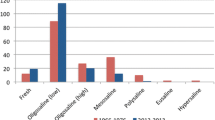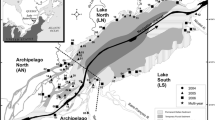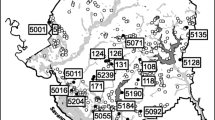Abstract
Geomorphic change, water resources development and climate change can alter the timing, frequency, magnitude and duration of replenishment of floodplain wetlands via overbank flows. If we understand the ecological consequences of these hydrological changes, environmental water allocations can be used more effectively to sustain wetland biodiversity and associated ecosystem processes. We analysed long-term monitoring data for 13 wetlands on the floodplain of the Murrumbidgee River in south-eastern Australia to determine how aquatic macroinvertebrate assemblages related to the proportion of time during which a wetland contained water. The more temporary wetlands had significantly different and poorer assemblages than the more permanent ones, with frequency of occurrence significantly negatively related to permanence for eight invertebrate genera and positively related for 17. The invertebrates most strongly associated with more temporary wetlands were mainly crustaceans whose resting stages withstand drying, together with highly mobile insects. Those associated with more permanent wetlands included a prawn, molluscs and less mobile insects. These findings suggest that maintaining a broad spectrum of hydrological regimes at the local scale is necessary if macroinvertebrate diversity on the Murrumbidgee River floodplain is to be sustained.




Similar content being viewed by others
References
Anderson JT, Smith LM (2004) Persistence and colonization strategies of playa wetland invertebrates. Hydrobiologia 513:77–86
Barclay MH (1966) An ecological study of a temporary pond near Auckland, New Zealand. New Zealand Journal of Marine and Freshwater Research 17:239–258
Batzer DP (2013) The seemingly intractable ecological responses of invertebrates in North American wetlands: a review. Wetlands 33:1–15
Batzer DP, Wissinger SA (1996) Ecology of insect communities in nontidal wetlands. Annual Review of Entomology 41:75–100
Batzer DP, Rader RB, Wissinger SA (eds) (1999) Invertebrates in freshwater wetlands of North America: ecology and management. Wiley, New York
Batzer DP, Palik BJ, Buech R (2004) Relationships between environmental characteristics and macroinvertebrate communities in seasonal woodland ponds of Minnesota. Journal of the North American Benthological Society 23:50–68
Boulton AJ, Lloyd LN (1991) Macroinvertebrate assemblages in floodplain habitats of the lower River Murray, South Australia. Regulated Rivers: Research and Management 6:183–201
Boulton AJ, Lloyd LN (1992) Flooding frequency and invertebrate emergence from dry floodplain sediments of the River Murray, Australia. Regulated Rivers: Research and Management 7:137–151
Brock MA, Nielsen DL, Shiel R, Green JD, Langley JD (2003) Drought and aquatic community resilience: the role of eggs and seeds in sediments of temporary wetlands. Freshwater Biology 48:1207–1218
Brooks RT (2000) Annual and seasonal variation and the effects of hydroperiod on benthic macroinvertebrates of seasonal forest (“vernal”) ponds in central Massachusetts, USA. Wetlands 20:707–715
Bunn SE, Arthington AH (2002) Basic principles and ecological consequences of altered flow regimes for aquatic biodiversity. Environmental Management 30:492–507
Burdett AS, Watts RJ, Jansen A (2005) Invertebrate fauna of small, temporary wetlands in agroecosystems on the Murrumbidgee floodplain, Australia. Verhandlungen der Internationale Vereinigung für Theoretische und Angewandte Limnologie 29:961–964
Collinson NH, Biggs J, Corfield A, Hodson MJ, Walker D, Whitfield M, Williams PJ (1995) Temporary and permanent ponds: an assessment of the effects of drying out on the conservation value of aquatic macroinvertebrate communities. Biological Conservation 74:125–133
Colwell RK, Chao A, Gotelli NJ, Lin S-Y, Mao CX, Chazdon RL, Longino JT (2012) Models and estimators linking individual-based and sample-based rarefaction, extrapolation and comparison of assemblages. Journal of Plant Ecology 5:3–21
Corti D, Kohler SL, Sparks RE (1997) Effects of hydroperiod and predation on a Mississippi River floodplain invertebrate community. Oecologia 109:154–165
Della Bella V, Bazzanti M, Chiarotti F (2005) Macroinvertebrate diversity and conservation status of Mediterranean ponds in Italy: water permanence and mesohabitat influence. Aquatic Conservation: Marine and Freshwater Ecosystems 15:583–600
Dietz-Brantley SE, Taylor BE, Batzer DP, DeBiase AE (2002) Invertebrates that aestivate in dry basins of Carolina bay wetlands. Wetlands 22:767–775
Dorn NJ (2008) Colonization and reproduction of large macroinvertebrates are enhanced by drought-related fish reductions. Hydrobiologia 605:209–218
Driver PD, Raine A, Foster ND, Williams SA (2013) Ecological monitoring to support Water Sharing Plan evaluation and protect wetlands of inland New South Wales, Australia. Ecological Management and Restoration 14:187–193
Euliss NH Jr, Mushet DM (2004) Impacts of water development on aquatic macroinvertebrates, amphibians, and plants in wetlands of a semi-arid landscape. Aquatic Ecosystem Health and Management 7:73–84
Florencio M, Díaz-Paniagua C, Serrano L, Bilton DT (2011) Spatio-temporal nested patterns in macroinvertebrate assemblages across a pond network with a wide hydroperiod range. Oecologia 166:469–483
Foggo A, Rundle SD, Bilton DT (2003) The net result: evaluating species richness extrapolation techniques for littoral pond invertebrates. Freshwater Biology 48:1756–1764
Frazier P, Page K (2006) The effect of river regulation on floodplain wetland inundation, Murrumbidgee River, Australia. Marine and Freshwater Research 57:133–141
Frazier P, Page K, Read A (2005) Effects of flow regulation on flow regime in the Murrumbidgee River, south eastern Australia: an assessment using a daily estimation hydrological model. Australian Geographer 36:301–314
Graham S (2009) Irrigators’ attitudes towards environmental flows for wetlands in the Murrumbidgee, Australia. Wetlands Ecology and Management 17:303–316
Green AJ, Jenkins KM, Bell D, Morris PJ, Kingsford RT (2008) The potential role of waterbirds in dispersing invertebrates and plants in arid Australia. Freshwater Biology 53:380–392
Hanson MA, Bowe SE, Ossman FG, Fieberg J, Butler MG, Koch R (2009) Influences of forest harvest and environmental gradients on aquatic invertebrate communities of seasonal ponds. Wetlands 29:884–895
Hardwick L, Maguire J, Foreman M, Frazier P (2001) Providing water to Murrumbidgee billabongs—maximising ecological value. In: Rutherfurd I, Sheldon F, Brierley G, Kenyon C (eds) Proceedings of the 3rd Australian Stream Management Conference, Brisbane, 27–29 August 2001. Cooperative Research Centre for Catchment Hydrology, Melbourne, pp 277–284
Hassall C, Hollinshead J, Hull A (2011) Environmental correlates of plant and invertebrate species richness in ponds. Biodiversity and Conservation 20:3189–3222
Hillman TJ, Quinn GP (2002) Temporal changes in macroinvertebrate assemblages following experimental flooding in permanent and temporary wetlands in an Australian floodplain forest. River Research and Applications 18:137–154
Jenkins KM, Boulton AJ (1998) Community dynamics of invertebrates emerging from reflooded lake sediments: flood pulse and Aeolian influences. International Journal of Ecology and Environmental Sciences 24:179–182
Jenkins KM, Boulton AJ (2003) Connectivity in a dryland river: short-term aquatic microinvertebrate recruitment following floodplain inundation. Ecology 84:2708–2723
Jenkins KM, Boulton AJ (2007) Detecting impacts and setting restoration targets in arid-zone rivers: aquatic micro-invertebrate responses to reduced floodplain inundation. Journal of Applied Ecology 44:823–832
Jenkins KM, Boulton AJ, Ryder DS (2005) A common parched future? Research and management of Australian arid-zone floodplain wetlands. Hydrobiologia 552:57–73
Junk WJ, Bayley PB, Sparks RE (1989) The flood pulse concept in river-floodplain systems. Canadian Special Publication of Fisheries and Aquatic Sciences 106:110–127
Kappes H, Haase P (2012) Slow, but steady: dispersal of freshwater molluscs. Aquatic Sciences 74:1–14
Kingsford RT (2000) Ecological impacts of dams, water diversions and river management on floodplain wetlands in Australia. Austral Ecology 25:109–127
Kingsford RT, Thomas RF (2004) Destruction of wetlands and waterbird populations by dams and irrigation on the Murrumbidgee River in arid Australia. Environmental Management 34:383–396
Lake PS, Bond N, Reich P (2006) Floods down rivers: from damaging to replenishing forces. Advances in Ecological Research 39:41–62
Mantel N (1967) The detection of disease clustering and a generalized regression approach. Cancer Research 27:209–220
McCauley SJ (2006) The effects of dispersal and recruitment limitation on community structure of odonates in artificial ponds. Ecography 29:585–595
McCune B, Mefford MJ (1999) PC-ORD. Multivariate analysis of ecological data, version 4, MJM Software Design, Gleneden Beach, Oregon
Moran MD (2003) Arguments for rejecting the sequential Bonferroni in ecological studies. Oikos 100:403–405
Niggebrugge K, Durance I, Watson AM, Leuven RSEW, Ormerod SJ (2007) Applying landscape ecology to conservation biology: spatially explicit analysis reveals dispersal limits on threatened wetland gastropods. Biological Conservation 139:286–296
Page K, Nanson G, Price D (1996) Chronology of Murrumbidgee River palaeochannels on the Riverine Plain, southeastern Australia. Journal of Quaternary Science 11:311–326
Perneger TV (1998) What’s wrong with Bonferroni adjustments. British Medical Journal 316:1236–1238
Pittock J, Finlayson CM (2011) Australia’s Murray-Darling Basin: freshwater ecosystem conservation options in an era of climate change. Marine and Freshwater Research 62:232–243
Puckridge JT, Costelloe JF, Reid JRW (2010) Ecological responses to variable water regimes in arid-zone wetlands: Coongie Lakes, Australia. Marine and Freshwater Research 61:832–841
Quinn GP, Hillman TJ, Cook R (2000) The responses of macroinvertebrates to inundation in floodplain wetlands: a possible effect of river regulation? Regulated Rivers: Research and Management 16:469–477
Robinson CT, Tockner K, Ward JV (2002) The fauna of dynamic riverine landscapes. Freshwater Biology 47:661–677
Rundle SD, Foggo A, Choiseul V, Bilton DT (2002) Are distribution patterns linked to dispersal mechanism? An investigation using pond invertebrate assemblages. Freshwater Biology 47:1571–1581
Sedell JR, Froggatt JL (1984) Importance of streamside forests to large rivers: the isolation of the Willamette River, Oregon, U.S.A., from its floodplain by snagging and streamside forest removal. Verhandlungen der Internationale Vereinigung für Theoretische und Angewandte Limnologie 22:1828–1834
Serrano L, Fahd K (2005) Zooplankton communities across a hydroperiod gradient of temporary ponds in the Doñana National Park (SW Spain). Wetlands 25:101–111
Sheldon F, Puckridge JT (1998) Macroinvertebrate assemblages of Goyder Lagoon, Diamantina River, South Australia. Transactions of the Royal Society of South Australia 122:17–31
Sheldon F, Walker KF (1997) Changes in biofilms induced by flow regulation could explain extinctions of aquatic snails in the lower River Murray, Australia. Hydrobiologia 347:97–108
Sheldon F, Walker KF (1998) Spatial distribution of littoral invertebrates in the lower Murray-Darling River system, Australia. Marine and Freshwater Research 49:171–182
Sheldon F, Boulton AJ, Puckridge JT (2002) Conservation value of variable connectivity: aquatic invertebrate assemblages of channel and floodplain habitats of a central Australian arid-zone river, Cooper Creek. Biological Conservation 103:13–31
Spencer M, Blaustein L, Schwartz SS, Cohen JE (1999) Species richness and the proportion of predatory animal species in temporary freshwater pools: relationships with habitat size and permanence. Ecology Letters 2:157–166
Stenert C, Maltchick L (2007) Influence of area, altitude and hydroperiod on macroinvertebrate communities in southern Brazil wetlands. Marine and Freshwater Research 58:993–1001
Tarr TL, Baber MJ, Babbitt KJ (2005) Macroinvertebrate community structure across a wetland hydroperiod gradient in southern New Hampshire, USA. Wetlands Ecology and Management 13:321–334
Tockner K, Stanford JA (2002) Riverine flood plains: present state and future trends. Environmental Conservation 29:308–330
Tockner K, Pusch M, Borchardt D, Lorang MS (2010) Multiple stressors in coupled river-floodplain ecosystems. Freshwater Biology 55(suppl 1):135–151
Tronstad LM, Tronstad BP, Benke AC (2007) Aerial colonization and growth: rapid invertebrate responses to temporary aquatic habitats in a river floodplain. Journal of the North American Benthological Society 26:460–471
Vanschoenwinkel B, Hulsmans A, de Roeck E, de Vries C, Seaman M, Brendonck L (2009) Community structure in temporary freshwater pools: disentangling the effects of habitat size and hydroregime. Freshwater Biology 54:1487–1500
Ward JV, Tockner K, Schiemer F (1999) Biodiversity of floodplain river ecosystems: ecotones and connectivity. Regulated Rivers: Research and Management 15:125–139
Waterkeyn A, Grillas P, Vanschoenwinkel B, Brendonck L (2008) Invertebrate community patterns in Mediterranean temporary wetlands along hydroperiod and salinity gradients. Freshwater Biology 53:1808–1822
Wen L (2009) Reconstruction natural flow in a regulated system, the Murrumbidgee River, Australia, using time series analysis. Journal of Hydrology 364:216–226
Whiles MR, Goldowitz BS (2001) Hydrologic influences on insect emergence production from Central Platte River wetlands. Ecological Applications 11:1829–1842
Whiles MR, Goldowitz BS (2005) Macroinvertebrate communities in central Platte River wetlands: patterns across a hydrologic gradient. Wetlands 25:462–472
Williams WD (1980) Australian freshwater life. Macmillan Publishing, Melbourne
Willie J, Petre C-A, Tagg N, Lens L (2012) Evaluation of species richness estimators based on quantitative performance measures and sensitivity to patchiness and sample grain size. Acta Oecologica 45:31–41
Winter TC (2000) The vulnerability of wetlands to climate change: a hydrologic landscape perspective. Journal of the American Water Resources Association 36:305–311
Wissinger SA (1999) Ecology of wetland invertebrates. Synthesis and applications for conservation and management. In: Batzer DP, Rader RB, Wissinger SA (eds) Invertebrates in freshwater wetlands of North America: ecology and management. Wiley, New York, pp 1043–1086
Zealand AM, Jeffries MJ (2009) The distribution of pond snail communities across a landscape: separating out the influence of spatial position from local habitat quality for ponds in south-east Northumberland, UK. Hydrobiologia 632:177–187
Acknowledgement
We thank James Maguire for his many contributions to the Integrated Monitoring of Environmental Flows program and the Australian Water Quality Centre and the former Water Science Laboratories for macroinvertebrate identification. Comments by the editor and two anonymous referees helped to improve the manuscript.
Author information
Authors and Affiliations
Corresponding author
Rights and permissions
About this article
Cite this article
Chessman, B.C., Hardwick, L. Water Regimes and Macroinvertebrate Assemblages in Floodplain Wetlands of the Murrumbidgee River, Australia. Wetlands 34, 661–672 (2014). https://doi.org/10.1007/s13157-014-0532-3
Received:
Accepted:
Published:
Issue Date:
DOI: https://doi.org/10.1007/s13157-014-0532-3




